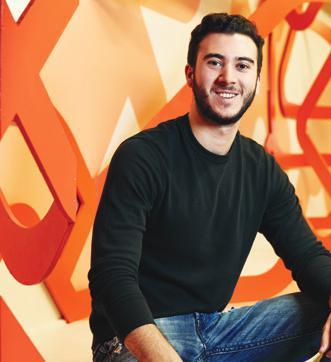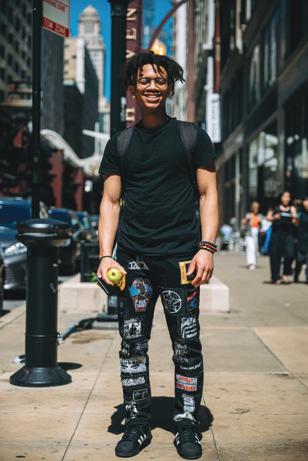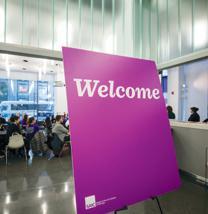International Students
Living in Chicago
Admission Requirements
Scholarships & Finance
International Student Services
Immigration & Visas


International Students
Living in Chicago
Admission Requirements
Scholarships & Finance
International Student Services
Immigration & Visas


While rooted in Chicago, our influence extends worldwide. Joining SAIC means becoming part of a global creative community, connecting students, faculty, visiting artists, and alumni across continents.
With over 150 years of history, the School of the Art Institute of Chicago (SAIC) stands as one of the world’s most influential art and design institutions. From artists to designers and visual scholars, SAIC has nurtured talent from every corner of the globe.
exceptionally diverse student community of our total student population is international 31%
international student body includes 1,100 students, joining us from over 80

1 You won’t declare a major
Our program is built for you to experiment across boundaries, immerse yourself in the ideas that interest you, and develop a practice, and portfolio, that is entirely your own.
2 Dedicated time for you to work
Experience real-world professional dynamics, learning to manage your projects and time. Dedicated studio time in five-hour studio courses meeting once a week allows you ample time to connect with other artists and your faculty to help you realize your artistic vision.
3 Your teachers have been there and made that
Our 700+ faculty members are practicing artists, designers, and scholars, passionate about mentoring their students and sharing their expertise and connections.
4 You’ll prepare for life after art school from day one
Connected to some of the most exciting and inventive employers in Chicago and globally, our internship program will help you develop the skills to succeed beyond art school.
5 Your Museum — one of the world’s most important collections
No other school of art and design can claim such a major museum as the Art Institute of Chicago as part of its campus. Visits to the museum are integral to your coursework, and a resource free to you.
6 The city of Chicago is yours
Chicago is a dream for young creatives. It’s livable and approachable. Our faculty and alums are deeply engaged in its cultural scene, opening doors to endless opportunities for you.
of SAIC international students who complete the necessary steps receive approval to participate in the Optional Practical Training (OPT) Program 99%

Bachelor of Fine Arts in Studio Our largest undergraduate degree
Bachelor of Arts in Art History
Bachelor of Fine Arts with an Emphasis in Art Education
Bachelor of Fine Arts with an Emphasis in Writing
Bachelor of Arts in Visual and Critical Studies
Explore our degrees in detail: saic.edu/ug_degrees
12,961 KM FROM SAIC
At SAIC, I have the flexibility to experiment, so there’s a sense of freedom. I’ve been studying interdisciplinary design at SAIC, and my work is very socially engaged. I’m a people person, and my work is all about designing and working with and for people. I’m involved in disaster relief, and community — engaged work, as well as human-centered design. SAIC gives me the resources to access these places, and the classes give me the theory to understand my intent. I’ve learned a lot about myself at SAIC. I’ve grown through the available resources, and SAIC has made me more independent.
“I’m responsible for everything I do here. Although that’s scary, it’s also liberating.”


Build a network for success
8,823 KM FROM SAIC
Türkiye / Designed Objects
SAIC is full of opportunities and lets you create your own path. There are designers and artists who will support your projects.
The connections I made through SAIC, and with my colleagues helped me grow as a designer. When you have an idea, you will have a lot of people to discuss it with. They understand you and that helps you grow.
Living in the residence hall made it so much easier to adapt to the city. There’s also a lot of work space available, and this was necessary and helpful for my work. I made a lot of friends too.
“Take
advantage of all SAIC has to offer, find your real passion, and go after it, and don’t forget to also socialize!”


The third-largest city in the U.S. with nearly 3 million people
2 international airports
77 distinctive neighborhoods, rich with cultural diversity
A thriving art scene with more than 400 galleries and theatres
Chicago boasts one of the world’s largest communities of working artists and designers. Here, you’ll live, explore, and practice your craft within a vibrant global and cultural hub.
Whether you’re searching for inspiration, practicing your craft, hanging out with friends, or enjoying a great meal, you’ll find Chicago has it all. No matter where you roam, Chicago is livable, affordable, and easy to get around via public transportation.
Over 100,000 college students are in proximity to our campus — the second-most populated college neighborhood in the U.S.
More than 600 parks and 31 kms of lakefront bicycle paths

Our campus, spanning about 5 square kilometers, is located in Chicago’s Loop — the city’s bustling tourism center. We’re surrounded by shops, restaurants, businesses, and luxury housing and neighbors to dozens of colleges.
Located in close proximity, our campus buildings include residence halls, studios, classrooms, reference libraries, and student services, and, of course, our museum, the world-class Art Institute of Chicago.

IT TAKES 10–15 MINUTES TO WALK FROM ONE END OF CAMPUS TO THE OTHER!

SAIC’s flexible interdisciplinary curriculum enabled me to explore different fields, helping me discover programs that helped expand my horizons.
The School provides great facilities and equipment for students, as well as weekly lectures, and social events. Chicago has everything: architecture, blues and jazz, comedy clubs, live music, astounding museums and attractions, nightlife, and theaters and performing arts. It is an extremely diverse, rich, and robust city. There is art in many forms, and groups of creative people — all with a strong sense of culture and history.
“If you love food, diversity, and adventure, there are numerous places to visit. Don’t forget to explore outside of the downtown Loop area.”
Ecuador / Printmedia & Visual Communication Design
SAIC has always pushed me to question myself, to question what I’m doing and why, and to look critically at my art — why is it working, or not working? We focus not only on how something looks, but what it means.
I haven’t grown tired of Chicago. Everything is moving — there are always gallery openings and concerts, and the cultural establishments are very organized. They just have it down.
“One piece of advice: Relax. You must have something to take your mind away from your studies, because it’s easy to get overwhelmed. Step away every once and awhile and say, ‘look at all this!”

Find a fresh point of view
Work together to share ideas

Trying other disciplines enabled me to create work that stands out from other graphic designers. My best piece is a data visualization from a combined class with professors and students from SAIC and Northwestern University.
We coded, used neon lights, designed graphics, and created an installation which was exhibited in the Neiman Center and at an off-campus site. I learned how to communicate ideas with art and non-art students, how to enjoy working collaboratively.
“SAIC helped me to explore ideas that inspire me, and produce work accordingly.”
12,848
My friends in China were all about fashion design, so naturally, I needed to go to an art school. I was initially attracted to traditional Chinese costumes, then I started making my own clothes — using old clothes and reconstructing them into something new.
I did an internship in New York City through SAIC at a small fashion design studio. The owner, a skilled fashion designer, had just established her brand two years prior. She was super nice, and it was a valuable experience because she really wanted me to be involved in her line — discussing the steps together, reviewing the designs, and making changes.
“My internship provider really liked to listen to my thoughts on the collection. It got me really involved with her work.”


the future
Ecuador / Sculpture and Foundry 4,763
I came here from Ecuador when I was 18 years old, thinking I was going to study art education.
The first time I stepped in SAIC’s metal shop, I got so excited — I had never been in one before. At first, it’s intimidating, but then you’re dominating those tools.
In Ecuador, I was in my comfort zone. In Chicago everything was new for me — the campus, the city, and the people. I’ve been open to meeting people from different backgrounds and getting outside of my comfort zone has really added to my artwork.
“SAIC has such amazing resources — from incredible faculty to amazing metal and wood shops, that I decided to develop myself as an artist.”



15,062
FROM SAIC Joseph
During my conscript military service, with little leisure time, I still found myself sketching.
I thought that despite the restrictions, if I still was making art, then maybe it should be something that I pursue. I came to SAIC from a drawing and painting background, but took photography in my second year, and fell in love because of its social nature.
I was also drawn to print and bookmaking, manifesting stories into three-dimensional objects that can be put in someone’s hands and brought home — not just limited to being viewed during museum hours, is an incredible gesture.
“The ability to share photographs, in an art world that seems to exclude so many, is inherently attractive.”


Find a journey of inspiration
The lens of a storyteller
SAIC’s interdisciplinary curriculum is liberating because you can explore all sorts of media and concepts. The first year is about getting out there, creating, and learning how to communicate your ideas and describe art. The lectures are super inspiring, helping you think about process and research, and how to be innovative. Get to know the resources — use the library, explore the Joan Flasch Artists’ Book Collection, and see the city. I go to the Art Institute of Chicago so often; I notice when they change paintings! I think I’ve grown a lot because of the teachers and the resources.
“Just get involved, care about your projects, do research, work hard, be humble, and defend your concepts.”

In addition to the admissions requirements for our degree programs available at saic.edu/ugapp, we’ll need proof of your English proficiency through the submission of one of the following:
Test of English as a Foreign Language (TOEFL) IBT
of English as a Foreign Language (TOEFL) essentials
* For the BA in Art History degree, a 96 TOEFL IBT is required.
You are not required to submit ACT, SAT or language assessment scores if:
» You are a U.S. resident or international student whose first language is English, or you are attending a U.S.–accredited high school abroad.
» You have studied in an English-language school for 4+ years.
» You have earned 12 or more semester hours of college credit from an English-language university.
If you believe your scores provide additional insight into your academic abilities, please feel free to submit them.
Students who achieve scores of 560 or higher on the SAT EvidenceBased Reading and Writing component, or scores of 21 or higher on the ACT Reading component, may be waived from the TOEFL/ IELTS/PTE/Duolingo language test requirements and English for International Students.

Some international students who speak English as a second language will need to take English for International Students (EIS) classes before they start Art History and Liberal Arts classes.
Students whose test scores meet our minimum requirement, but are below 96 TOEFL, 7.0 IELTS, 65 PTE, or 120 Duolingo, may take EIS fluency and critique classes before starting their other academic classes to best prepare them for a successful college experience.
saic.edu/ugmerit
SAIC awards its most substantial Merit Scholarships to incoming students — freshmen and transfer, domestic and international.
The Admissions Committee reviews and awards admitted students based on a holistic review of their portfolio, artist’s statement, academic record, and letter of recommendation.
This award is annually renewable as long as satisfactory academic standing, as outlined in your award letter, is maintained. We encourage you to begin the dialogue with Admissions about how to create a merit-worthy application as soon as you decide SAIC might be the school for you. Visit saic.edu/ugevents for ways to meet with us in-person and virtually.
saic.edu/internationalfinaid
A strong source of financial assistance is often from your home country.
The U.S. government does not provide funding for foreign nationals to study in the U.S. However, your home country may have funding resources for studying abroad. The International Financial Aid section of our website has helpful information and links to financial resources.
For information about scholarships for which you may qualify, visit saic.edu/outsidescholarships.
Students with F-1 visa status may work up to 20 hours a week during fall and spring terms, and up to 40 hours during winter and summer terms.
Jobs are available in many departments at SAIC, and we recommend beginning your job search soon after arriving on campus.

tinyurl.com/Elm-Select
Most loan agencies require a co-signer who is a U.S. citizen or permanent resident. Information on the private education loan process is available at finaid.org.
Choosing a Lender:
Elm Select at tinyurl.com/Elm-Select is a useful tool for students to explore lenders commonly used by SAIC students. It’s also wise for students to check with their own banking institutions or conduct online research to review and compare different loan options.
Making informed decisions about private education loans is crucial for selecting the best option that fits individual needs and financial circumstances.
Most loan applications can be done online, and should be submitted to the loan agency with all necessary supporting documentation, including a copy of your passport and immigration documents.
International Student Services provides you with the guidance you need to be successful at SAIC and beyond. We advise on a wide spectrum of matters, spanning from immigration regulations to available resources for achieving your academic, financial, and personal objectives. At every point in your journey, our expert team will be here to help — from determining everything you need to arrive on campus, to meeting new friends, and flourishing in a new culture.
We provide:
» Specialized programming related to your visa status
» Customized orientation programming for incoming students
» Workshops to help you achieve your academic and personal goals
» Social programming including International Trivia Night
» Employment workshops
We organize workshops year-round to educate international students on their immigration responsibilities and offer opportunities to enrich their academic experience at SAIC.
Our team members actively engage with NAFSA, the Association for International Educators, underscoring our commitment to:
» Mutual understanding among nations
» Equipping the next generation with essential cross-cultural and global competencies
» Cultivating an environment conducive to a more peaceful world



All new incoming students will participate in International Student Orientation. The program is here to help guide you through your immigration responsibilities and maintain your visa status while in the United States. You’ll also be introduced to essential support services and resources, to ensure a positive experience at SAIC.

Our International Student Services team will help guide you through the immigration process.
Our students typically come on the F-1 student visa, which requires you to be enrolled full-time during the academic year.
Canadian citizens also enter as F-1 students on SAIC-issued immigration documentation (1-20), but are exempt from the actual visa application process.
The U.S. government requires that all international applicants provide SAIC with evidence of your ability to pay a full year of tuition and living expenses before a Certificate of Eligibility (I-20) may be issued. To apply for your I-20, you will need to prepare the following documents:
» Completed immigration and financial matters online questionnaire
» Bank statement showing a full year of available funding
» Copy of your passport biographical page
» International declaration of intent (submitted online)
SAIC defines an international student as a non-U.S. Citizen, or non-U.S. Permanent Green Card Holder.
International students usually need an F-1 Student Visa, or J-1 Exchange Visitor Visa to study in the United States.
International Affairs
36 S. Wabash Ave. Suite 1203 Chicago, IL 60603
intaff@saic.edu
saic.edu/international
Moving abroad is a big step. We advocate for prospective students and their families to come explore Chicago and experience SAIC for yourselves. Additionally, we organize events globally to meet you in person, where you are.
We’d love to meet you. We hope to see you in Chicago, or to see you in your corner of the world, soon. A list of the events we host can be found at: Give us a call
saic.edu/ugevents
Email us ugadmiss@saic.edu
Visit saic.edu/ugevents to get started
Let’s Get Digital
Life at SAIC saic.edu/lifeatsaic instagram: see_saic tiktok: schooloftheartinstitute
SAIC International Affairs facebook.com/saic.internationalaffairs instagram: saicintaff
SAIC Careers saic.edu/capx facebook.com/saic.careers twitter.com/saiccareers
SAIC news and events facebook.com/saic.admissions twitter.com/saic_news

